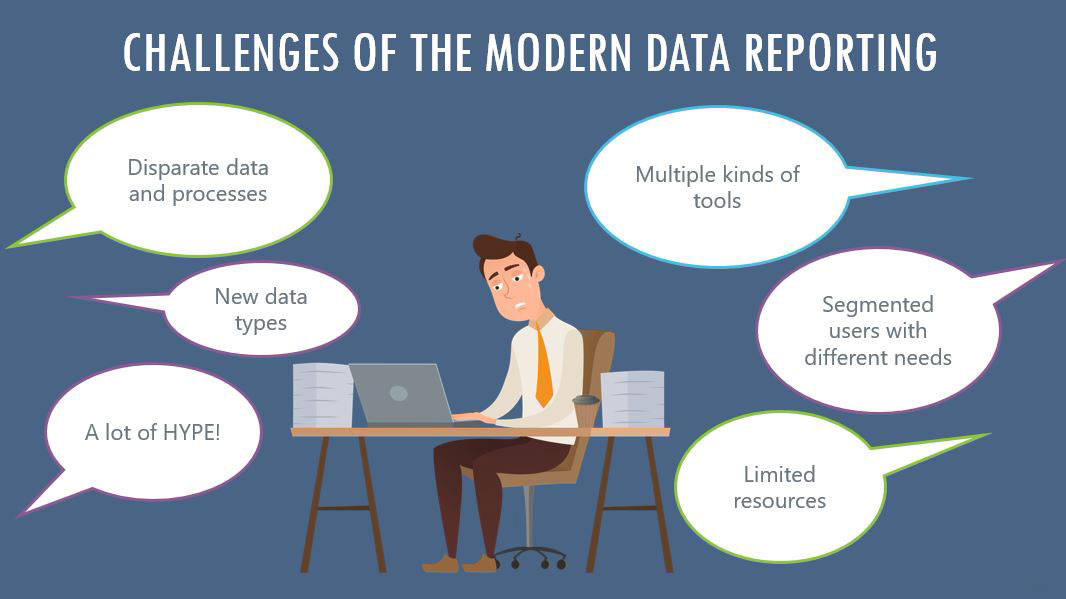Six Reasons You’re Not Engaging with Data as Much as You Should Be
Six Reasons You’re Not Engaging with Data as Much as You Should Be
Over the last two years, 75% of all the world’s data was generated. However, the majority of companies are only leveraging about 12% of the data that’s available to them. With an abundance of data at our disposal, why aren’t more organization capitalizing on the opportunity to make data analytics their competitive advantage? In our experience, the reasons are manifold.
Challenges of Modern Data Reporting
Disparate and cumbersome data processes
Data is never delivered in pretty packages. You’ll need to integrate your disparate data before you can glean any real insights. As you look for solutions to address this challenge, reducing complexity by leveraging some of the latest innovations in the cloud will be at the cornerstone of an effective data analytics solution.
New data types
As technologies that capture data proliferate, so do businesses’ abilities to contextualize data to draw new insights from it. Businesses can pull data from their website and social media pages, as well as a wide array of other new and emerging sources. This data doesn’t always come in pretty little packages; it can be structured or unstructured, on-premises or in the cloud. The faster organizations are able to store, aggregate, and analyze their data in a single place – the greater value they will derive. While the big data industry is growing and creating more confusion, the ability of infrastructure and information management to keep pace is within sight, you just have to know where to look!
Multiple kinds of tools
Cloud-based data analytics tools come in many shapes and sizes. Making the wrong decision for your needs, work culture, and budget can be an expensive mistake that comes with residual impact. When making your investment, make sure to choose a solution that covers all of your organization’s use cases, integrates well with your existing technology stack, is compatible with your organization’s data (size, accuracy of data), matches the level of sophistication of your users, and, ideally, is affordable. While there are a lot of solutions on the market, Power BI and Tableau are consistently recognized at the top contenders on the Gartner ‘Magic Quadrant.’
Segmented users with different needs
Users across different segments of the organization have different thoughts on how to capture and leverage data. When this is inconsistent throughout the organization, it is difficult to produce reports that can be consolidated or consumed by the entire company. Preparing your organization to leverage data as a business asset is more than just a technical undertaking; it requires input from the end-users as well. Strong data governance has emerged as a way to get the most out of your data assets. By increasing data understanding across the business, users are far more likely to use analytics to uncover unseen issues and opportunities.
Limited resources
As organizations progress down the path towards big data analytics, they’ll inevitably need more data experts as a continuous change in our digital economy requires a whole new set of skills. It is projected that by 2020, there will be a need for 700,000 new data scientists, developers, and engineers in the market. These highly sought-after professionals are already scarce, and it is becoming increasingly difficult for most businesses to attract, retain, and vet qualified applicants. Fortunately, more service providers are emerging that understand the needs of small to midsize businesses and can help bridge the skill gap and guide organizations of all sizes through their data transformation journeys.
A lot of hype
Stories abound about how data science has been applied to win the World Series, make millions, and even save lives. Data analytics has become the new hot topic of the day, but what is the difference between hype and reality in analytics? What’s really possible?
To be successful, data transformation must be seen as a holistic process that takes a number of factors into account. Partnering with a trusted solutions provider can help companies sift through the noise by leveraging specialized data analytics specialists on an as-needed basis.



SHARE